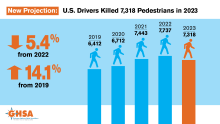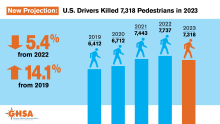Data from the US Department of Transportation's National Highway Traffic Safety Administration (NHTSA) shows that highway deaths increased to 33,561 in 2012, an increase of 1,082 over the figures for 2011.The official Fatality Analysis Reporting System (FARS) data reveals that the majority of the increase in deaths, some 72%, occurred in the first quarter of 2012. Most of those involved were motorcyclists and pedestrians. This newly released data marks the first increase in road related fatalities in the US
Data from the 2364 US Department of Transportation's 2467 National Highway Traffic Safety Administration (NHTSA) shows that highway deaths increased to 33,561 in 2012, an increase of 1,082 over the figures for 2011.The official Fatality Analysis Reporting System (FARS) data reveals that the majority of the increase in deaths, some 72%, occurred in the first quarter of 2012. Most of those involved were motorcyclists and pedestrians. This newly released data marks the first increase in road related fatalities in the US since 2005. However, highway deaths over the past five years continue to remain at historic lows. Fatalities in 2011 were at the lowest level since 1949 and even with this slight increase in 2012, the death rate is still at the same level of fatalities as 1950 when vehicle numbers were considerably lower and the Total distance driver/year was far less than today.
More encouraging is the fact that early estimates on crash fatalities for the first half of 2013 indicate a decrease in deaths compared to the same timeframe in 2012. "Highway deaths claim more than 30,000 lives each year and while we've made substantial progress over the past 50 years, it's clear that we have much more work to do," said US Transportation Secretary Anthony Foxx. "As we look to the future, we must focus our efforts to tackle persistent and emerging issues that threaten the safety of motorists, cyclists and pedestrians across the nation."
While Americans drove approximately the same distance in 2012 as in the previous year, the new FARS data released showed a 3.3% increase in fatalities from the previous year. The final 2012 numbers Confirm preliminary quarterly reports issued by the agency. Key 2012 statistics show that fatalities among pedestrians increased for the third consecutive year (a 6.4% increase over 2011). The data showed the large majority of pedestrian deaths occurred in urban areas, at non-intersections, at night and many involved alcohol.
In addition, motorcycle rider fatalities increased for the third consecutive year (a 7.1% increase over 2011). Ten times as many riders died not wearing a helmet in states without a universal helmet law than in states with such laws.
Large-truck occupant fatalities increased for the third consecutive year by 8.9% over 2011.
Deaths in crashes involving drunk drivers increased 4.6% in 2012, taking 10,322 lives compared to 9,865 in 2011. The majority of those crashes involved drivers with a blood alcohol concentration (BAC) of .15 or higher – nearly double the legal limit.
The number of people killed in distraction-affected crashes decreased slightly from 3,360 in 2011 to 3,328, while an estimated 421,000 people were injured, a 9% increase from the estimated 387,000 people injured in 2011. NHTSA is just beginning to identify distraction-related accidents, and is continuing work to improve the way it captures data to better quantify and identify potential trends in this area.
Night-time Seat belt use continues to be a challenge. In night-time crashes in 2012, almost two-thirds of the people that died were unrestrained.
"As a public health and safety agency, any increase in the number of deaths is cause for concern. While we're seeing some unfortunate trends, we're also seeing progress in some parts of the country," said NHTSA administrator David L Strickland. "We will continue to work closely with our federal, state and local partners to change the way motorists behave on our roadways and build public awareness of key issues that have the potential to save many lives."
In all 13 states and Washington DC experienced reductions in overall traffic fatalities, led by Mississippi (48 fewer), New Jersey (38), Georgia (34), Alabama (30) and Utah (26). In addition, 18 states and Washington D.C. showed decreases in drunk driving deaths. New Jersey had the greatest decrease (30 fewer) followed by Colorado (27), Utah (20), Oklahoma (17) and Virginia (17).
More encouraging is the fact that early estimates on crash fatalities for the first half of 2013 indicate a decrease in deaths compared to the same timeframe in 2012. "Highway deaths claim more than 30,000 lives each year and while we've made substantial progress over the past 50 years, it's clear that we have much more work to do," said US Transportation Secretary Anthony Foxx. "As we look to the future, we must focus our efforts to tackle persistent and emerging issues that threaten the safety of motorists, cyclists and pedestrians across the nation."
While Americans drove approximately the same distance in 2012 as in the previous year, the new FARS data released showed a 3.3% increase in fatalities from the previous year. The final 2012 numbers Confirm preliminary quarterly reports issued by the agency. Key 2012 statistics show that fatalities among pedestrians increased for the third consecutive year (a 6.4% increase over 2011). The data showed the large majority of pedestrian deaths occurred in urban areas, at non-intersections, at night and many involved alcohol.
In addition, motorcycle rider fatalities increased for the third consecutive year (a 7.1% increase over 2011). Ten times as many riders died not wearing a helmet in states without a universal helmet law than in states with such laws.
Large-truck occupant fatalities increased for the third consecutive year by 8.9% over 2011.
Deaths in crashes involving drunk drivers increased 4.6% in 2012, taking 10,322 lives compared to 9,865 in 2011. The majority of those crashes involved drivers with a blood alcohol concentration (BAC) of .15 or higher – nearly double the legal limit.
The number of people killed in distraction-affected crashes decreased slightly from 3,360 in 2011 to 3,328, while an estimated 421,000 people were injured, a 9% increase from the estimated 387,000 people injured in 2011. NHTSA is just beginning to identify distraction-related accidents, and is continuing work to improve the way it captures data to better quantify and identify potential trends in this area.
Night-time Seat belt use continues to be a challenge. In night-time crashes in 2012, almost two-thirds of the people that died were unrestrained.
"As a public health and safety agency, any increase in the number of deaths is cause for concern. While we're seeing some unfortunate trends, we're also seeing progress in some parts of the country," said NHTSA administrator David L Strickland. "We will continue to work closely with our federal, state and local partners to change the way motorists behave on our roadways and build public awareness of key issues that have the potential to save many lives."
In all 13 states and Washington DC experienced reductions in overall traffic fatalities, led by Mississippi (48 fewer), New Jersey (38), Georgia (34), Alabama (30) and Utah (26). In addition, 18 states and Washington D.C. showed decreases in drunk driving deaths. New Jersey had the greatest decrease (30 fewer) followed by Colorado (27), Utah (20), Oklahoma (17) and Virginia (17).






